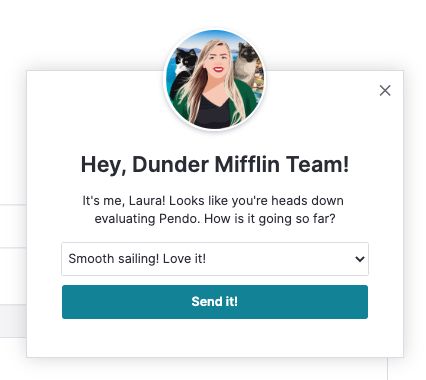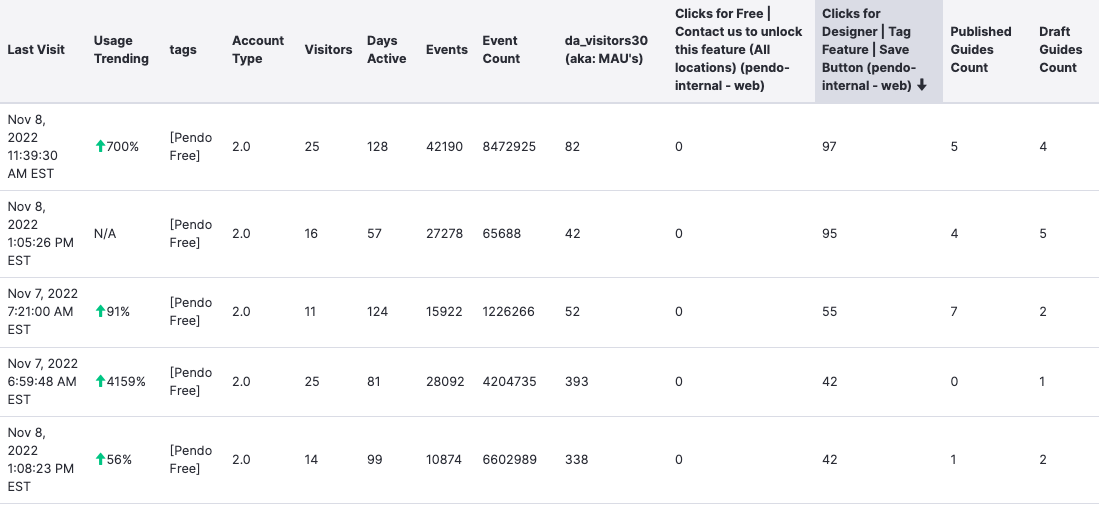“Have they logged in this week?” “Have they used this key feature?” “Have they invited others to their trial?”
As a manager on the sales team at Pendo, these are some of the questions I ask every day. And I know this isn’t the norm for all sales organizations. I’m spoiled by having this product usage data at my fingertips, and the ability to ask any question of that data. I can check in with my prospects during their free trial without having to call them. Our own product allows me and my team to put the customer experience at the center of everything we do—helping us leverage product-led strategies as a sales organization.
In my four years at Pendo, I’ve served as a sales development representative (SDR), account executive, senior account executive, and now a sales manager. I’ve pitched our product, demoed our product, sold our product—and yes, even used our product to do my job more effectively.
Pendo enables teams to understand user behavior (and what’s driving it) and turn those insights into action with in-app communication. While Pendo was initially conceived as a solution for product teams, the product has continued to evolve and can benefit anyone who touches the customer experience—including sales. Here are three ways I use Pendo as a member of the revenue team:
1. Understanding current state and upsell opportunities
When we released Pendo Feedback in 2019, I was on the customer growth team, which focused on helping customers get more out of Pendo by adding new products and integrations to their Pendo subscription.
As an SDR trying to determine which customers would have the most interest in Pendo Feedback, I was presented with a challenge: while the marketing team has its own strategy and plan in place, how can I identify and surface customers for potential expansion? I needed a way to take what we knew about our customers to fuel my own outreach.
At the time, we already had some customers using Pendo’s in-app surveys and NPS capabilities to drive their customer feedback process, but it didn’t allow for ongoing, open-ended feedback and feature requests. It was a solution, but not the whole solution. Knowing this, I used Pendo’s product analytics to surface a list of possible accounts for upsell for Pendo Feedback. This was defined as:
- Users that had created three or more polls or surveys
- Persona (role) contains Product, Product Marketing, Support, or Success
Looking at a Visitor Report for this segment, I added additional columns to surface more information about these users: visitor name, account owner, number of visits to the Guide Metrics or Polls and Surveys pages, and number of times they downloaded a CSV of their NPS responses (all for the previous six months).
This generated a list of over 100 unique visitors with a strong possible fit for Pendo Feedback: users who were already using our survey capabilities and who regularly built and shipped new features, as well as companies with multiple product offerings that regularly built new products. I also wanted to target users with high usage of Pendo, high NPS scores, and a title in product, product operations, or customer success. In short, I was looking for users who could either benefit from a better way to collect feedback or who received a lot of feedback and had no way to organize and ensure it was put to good use.
From there, I was better able to personalize my outreach to these users, since I had insight into their current processes and workflows. Being able to identify existing behaviors and personas that aligned with the key value drivers of our new offering made every conversation easier. Since I already knew what these users were doing, I was able to provide the right details on the additional value they’d get from Pendo Feedback. Today, it’s exciting to see that many of these users are now Pendo Feedback customers.
2. Understanding what trial users do and how they feel
When I moved into an account executive role, there were new challenges—and opportunities. In the Pendo sales process, we often support Proof of Concept or Proof of Technology trials and there are certain KPIs we look for to better understand a trial’s health and success.
In a perfect world, consistent check-ins and communication would be seamless, but when working with busy teams, it’s not always easy to get on the same page during this trial period. Most of the time we want to understand what they’ve tested, what they haven’t, and what level of involvement they have had in our product.
Here are some healthy trial behaviors we look for:
- Have they invited other team members (and executives) to Pendo?
- Have they used the core features we identified in our trial plan?
- Have they spent enough time in the product?
- Have they engaged with our knowledge base?
After using Pendo data to answer these questions, we’ve been able to identify key indicators of a successful trial. More importantly, we’re able to better engage with these prospects based on their actions in the product during the trial period.
In addition to understanding trial users’ behavior, one of the biggest challenges is getting insight into how these teams are feeling. Not everyone wants to (or has time to) communicate with a sales rep, but feedback during the presales process is crucial to understanding if users are seeing value, or if there’s something happening that we should know about.
In the spirit of “drinking our own champagne,” I turned to another product-led tactic that Pendo enables: in-app communication and collecting feedback from users in-app. I used in-app guides to create polls and check in with my prospects, knowing that I’ll reach them while they are actively engaging with the product. Creating this personalized experience proved effective: In the year and a half it was live, 76% of trial users who viewed the above in-app guide became Pendo customers.
3. Understanding where to focus growth efforts
Now that I have the pleasure of leading a team of incredible sales reps at Pendo, there’s even more ways to use our product to support my team and our customers. With the launch of Pendo Free in 2021, we saw a major influx of startups taking advantage of this new entry level offering.
Pendo Free offers a ton of great features but keeps some of the bigger-ticket items reserved for paid customers. Our team has been using Pendo data to see when named accounts in Salesforce create a Pendo Free account, how often they’re using the free product, and if (and how often) they’ve engaged with key features or the upgrade button without completing that workflow. Here’s an example of what this looks like in Pendo:
Now, when we communicate with these users (either in-app or via email), we already have an idea of their needs, based on what they’re doing in Pendo Free. This means we can better tailor our outreach and present outcomes and value drivers that we know they’ll appreciate from the full Pendo platform.
As a sales leader with access to everything in Pendo, I’m able to help my team better understand where to focus efforts. I can help spot greenspace and low hanging fruit, share what successful conversions should look like, identify key indicators of success in the middle of a sales cycle, and help sales reps better understand what’s happening in their own accounts as we continue to expand our own product-led efforts.
They say that the majority of selling happens when a salesperson isn’t in the room. These days, a lot of that happens while prospective customers are inside the product. This doesn’t have to be a blind spot—for product-led teams, it can be a superpower.


![[object Object]](https://cdn.builder.io/api/v1/image/assets%2F6a96e08774184353b3aa88032e406411%2F39f3ccde352b460cbf348ccc952054cd?format=webp)



